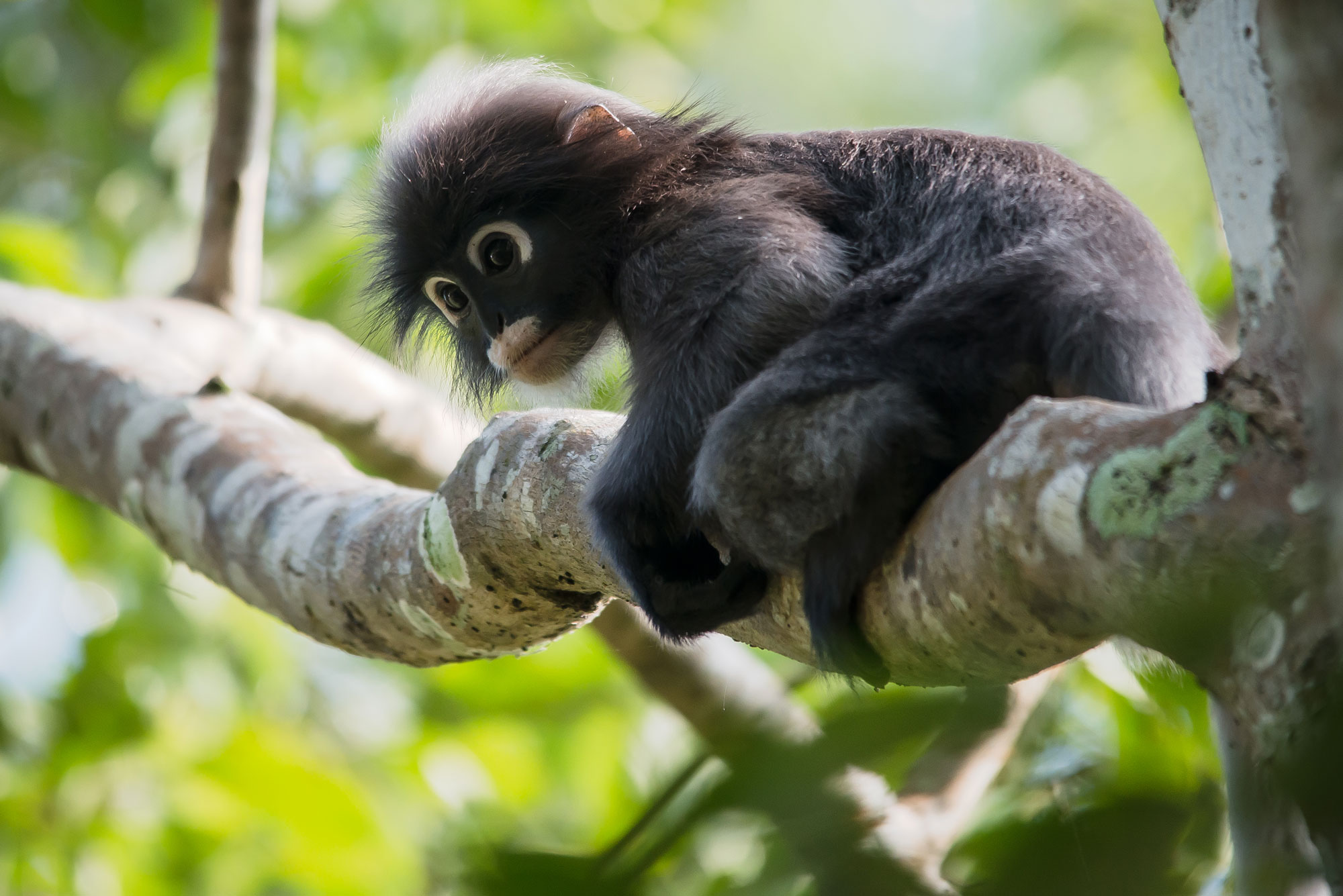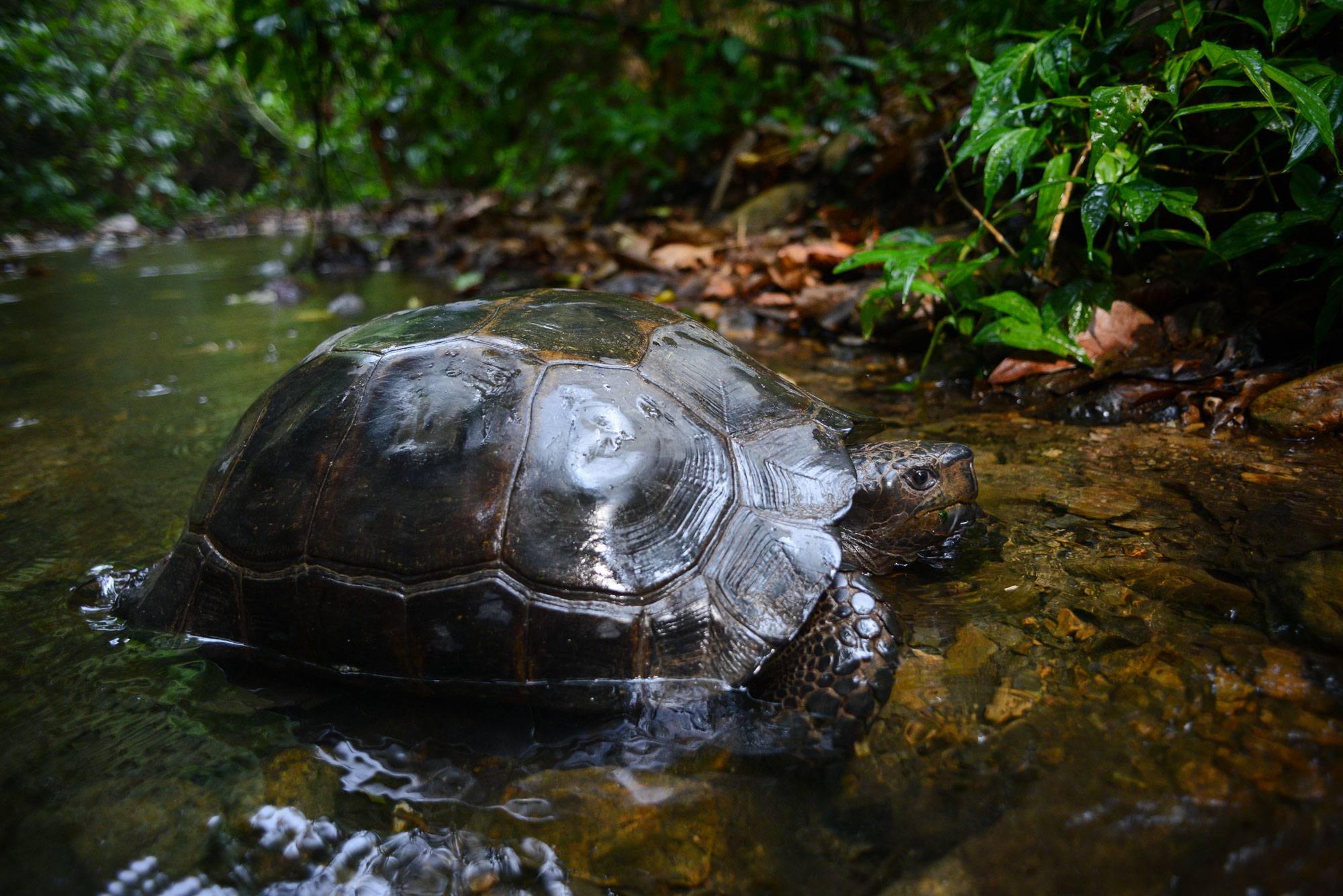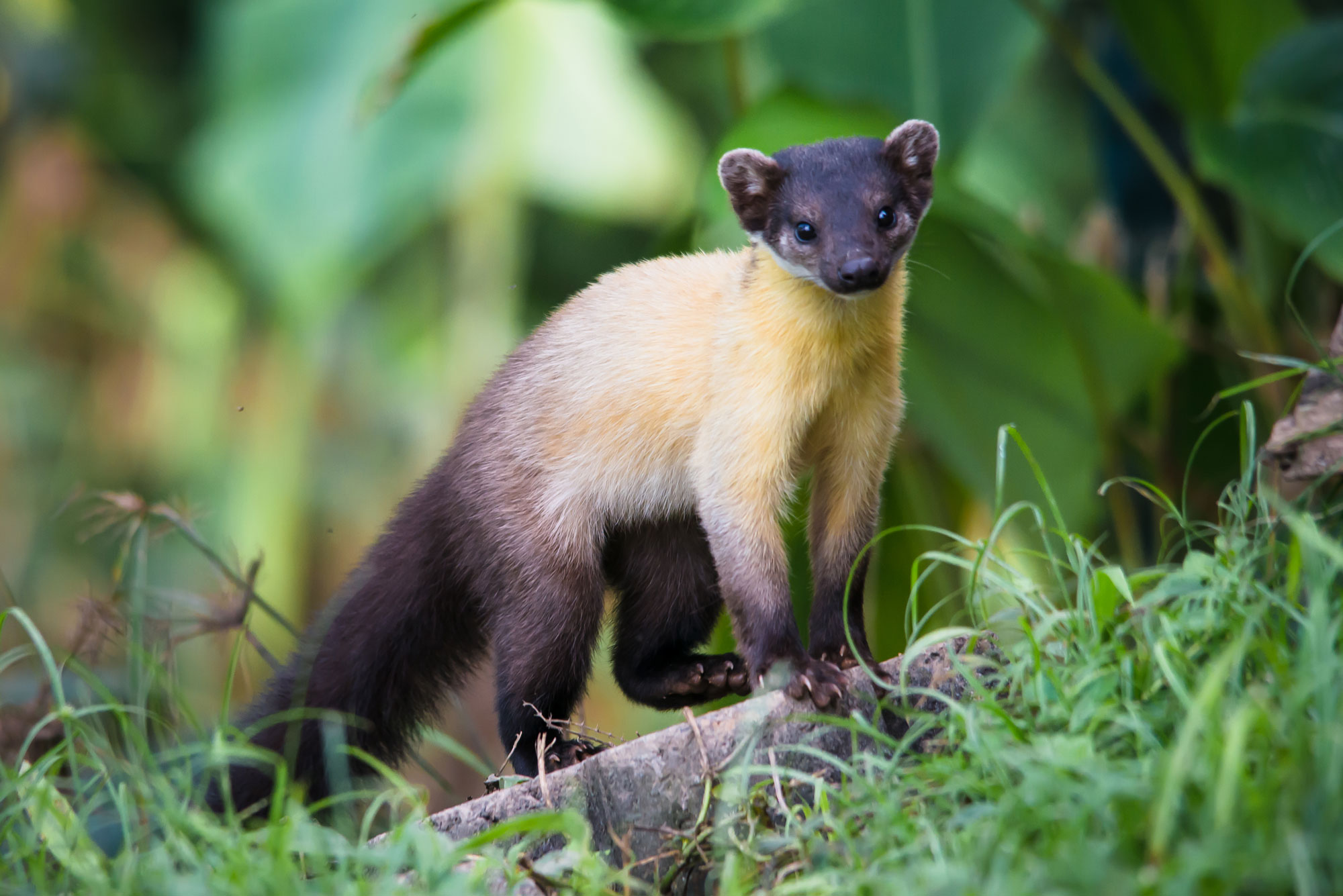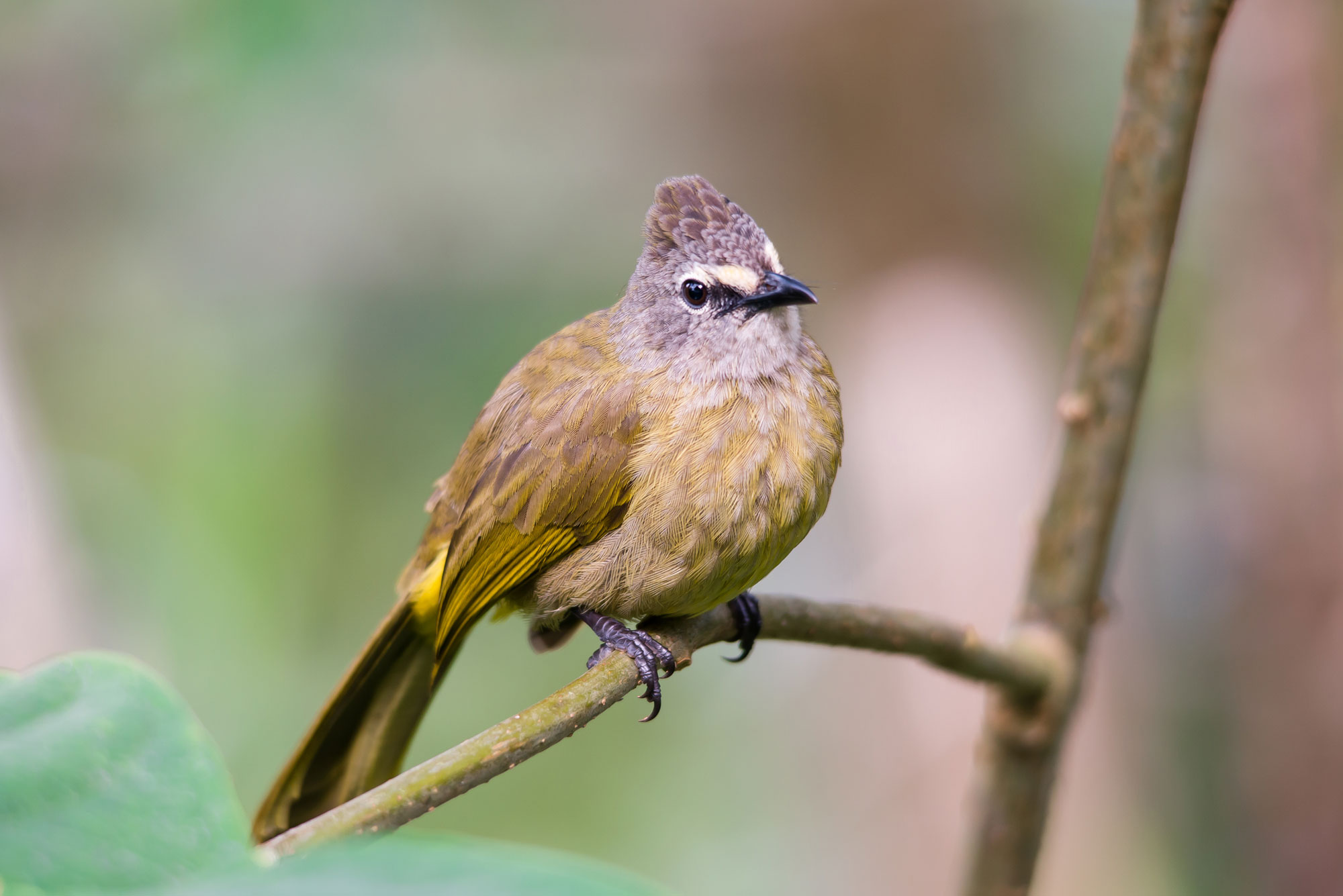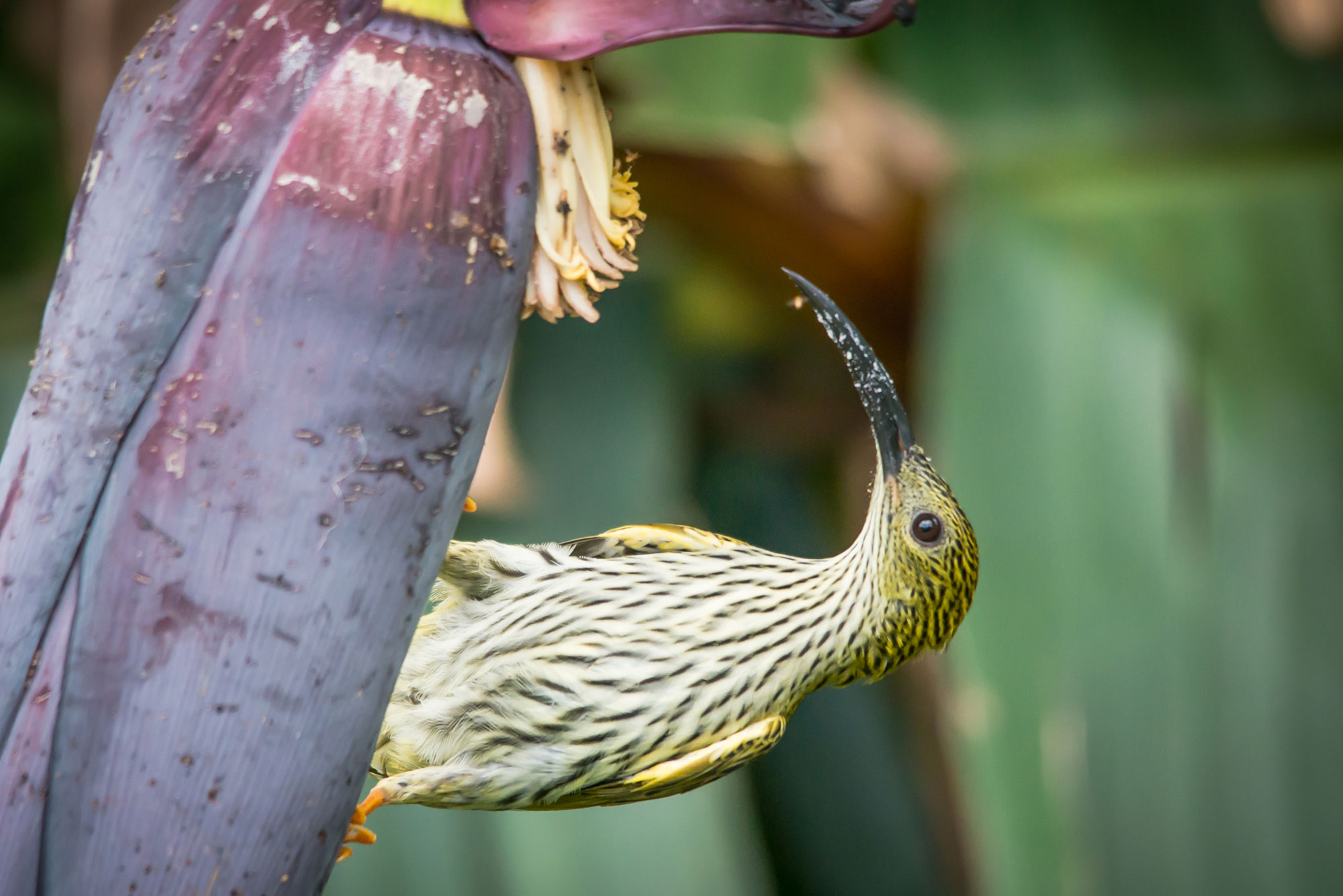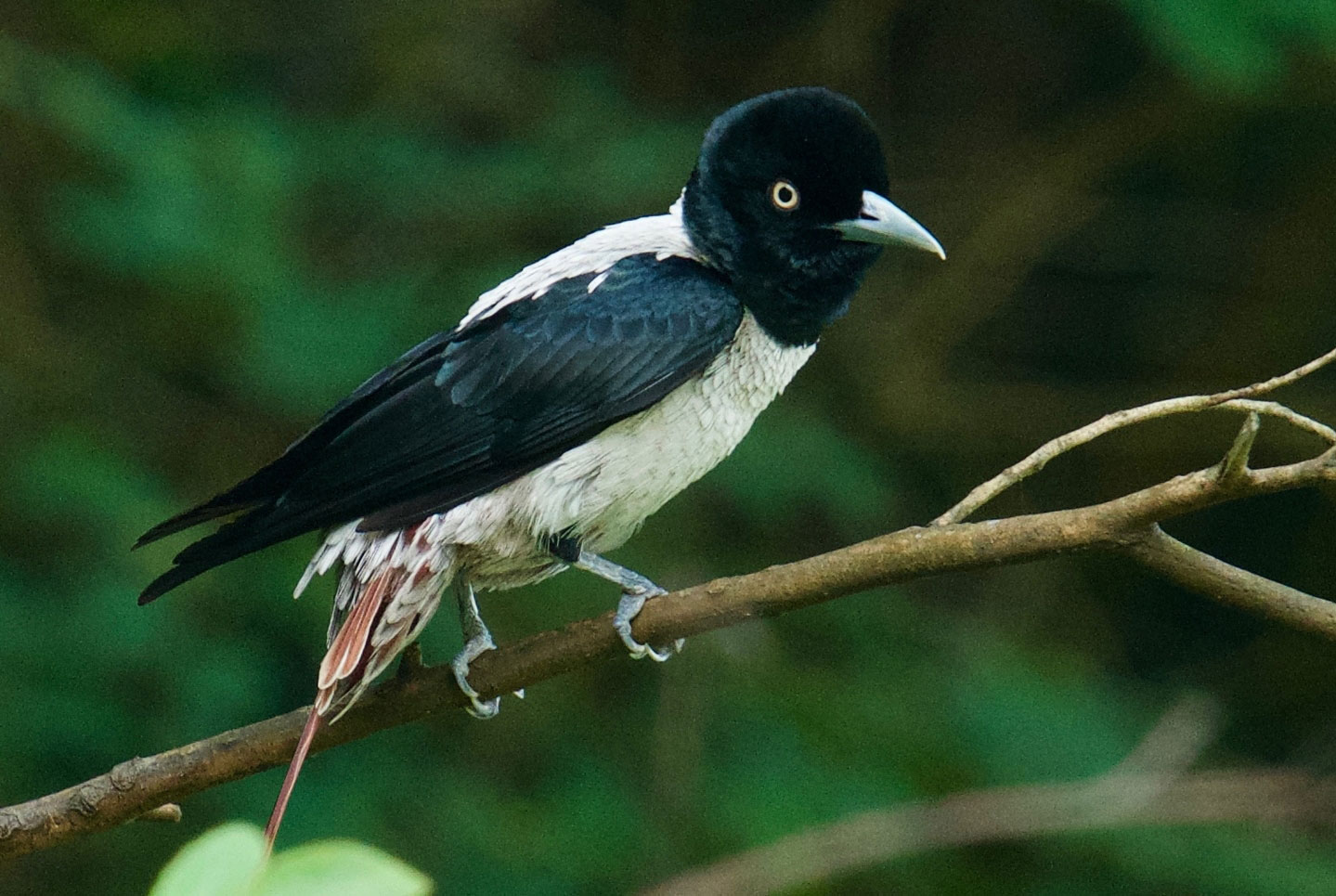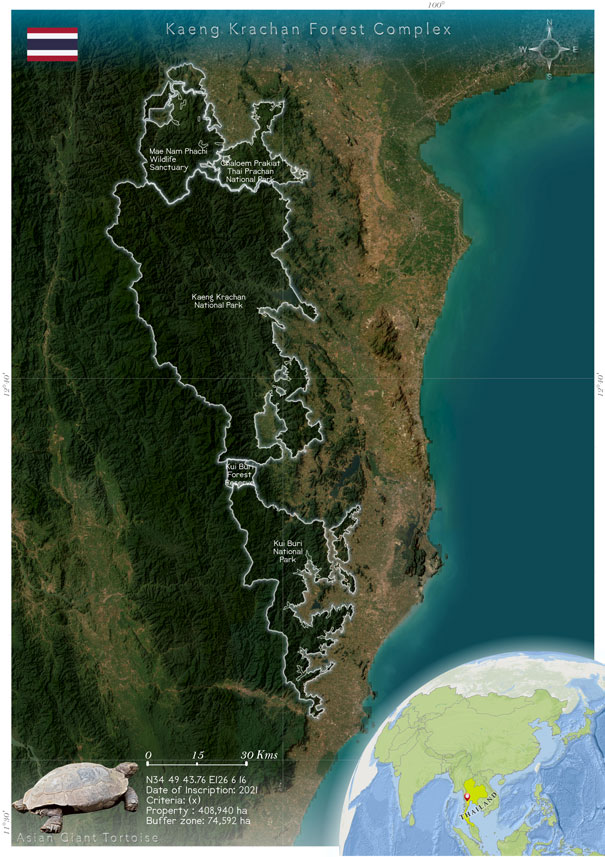
Kaeng Krachan Forest Complex
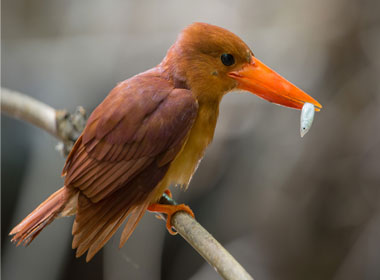 The KKFC, known as the Khao Kho-Klong Lan-Fang Conservation Area, is positioned along the Tenasserim Range, forming a boundary shared by Thailand and Myanmar. Encompassing a vast forested region that spans three provinces in western Thailand— Ratchaburi, Phetchaburi, and Prachuab Kirikhan—this conservation area is situated within the larger Indo- Malayan ecoregion. At a broader scale, the KKFC stands out for its remarkable biological diversity, owing to its unique position as a convergence point for four distinct zoogeographical subregions and four floristic provinces (Indo-Burmese or Himalayan, Indo-Malaysian, and Andamanese). The micro-level diversity of the site is equally impressive, owing to its diverse geological attributes and varying topography, which together contribute to an extraordinary array of habitats within a relatively small area. The presence of endemic and endangered species within the KKFC serves as concrete evidence of its exceptional biodiversity. Furthermore, the conservation area supports substantial populations of various species that hold global endangered status. Recognizing its ecological importance, the International Union for Conservation of Nature (IUCN) designates the KKFC as a regionally significant landscape for tiger conservation, an important bird area, a crucial zone for elephant preservation, and a prioritized site within the context of the Indo-Burma hotspots.
The KKFC, known as the Khao Kho-Klong Lan-Fang Conservation Area, is positioned along the Tenasserim Range, forming a boundary shared by Thailand and Myanmar. Encompassing a vast forested region that spans three provinces in western Thailand— Ratchaburi, Phetchaburi, and Prachuab Kirikhan—this conservation area is situated within the larger Indo- Malayan ecoregion. At a broader scale, the KKFC stands out for its remarkable biological diversity, owing to its unique position as a convergence point for four distinct zoogeographical subregions and four floristic provinces (Indo-Burmese or Himalayan, Indo-Malaysian, and Andamanese). The micro-level diversity of the site is equally impressive, owing to its diverse geological attributes and varying topography, which together contribute to an extraordinary array of habitats within a relatively small area. The presence of endemic and endangered species within the KKFC serves as concrete evidence of its exceptional biodiversity. Furthermore, the conservation area supports substantial populations of various species that hold global endangered status. Recognizing its ecological importance, the International Union for Conservation of Nature (IUCN) designates the KKFC as a regionally significant landscape for tiger conservation, an important bird area, a crucial zone for elephant preservation, and a prioritized site within the context of the Indo-Burma hotspots.
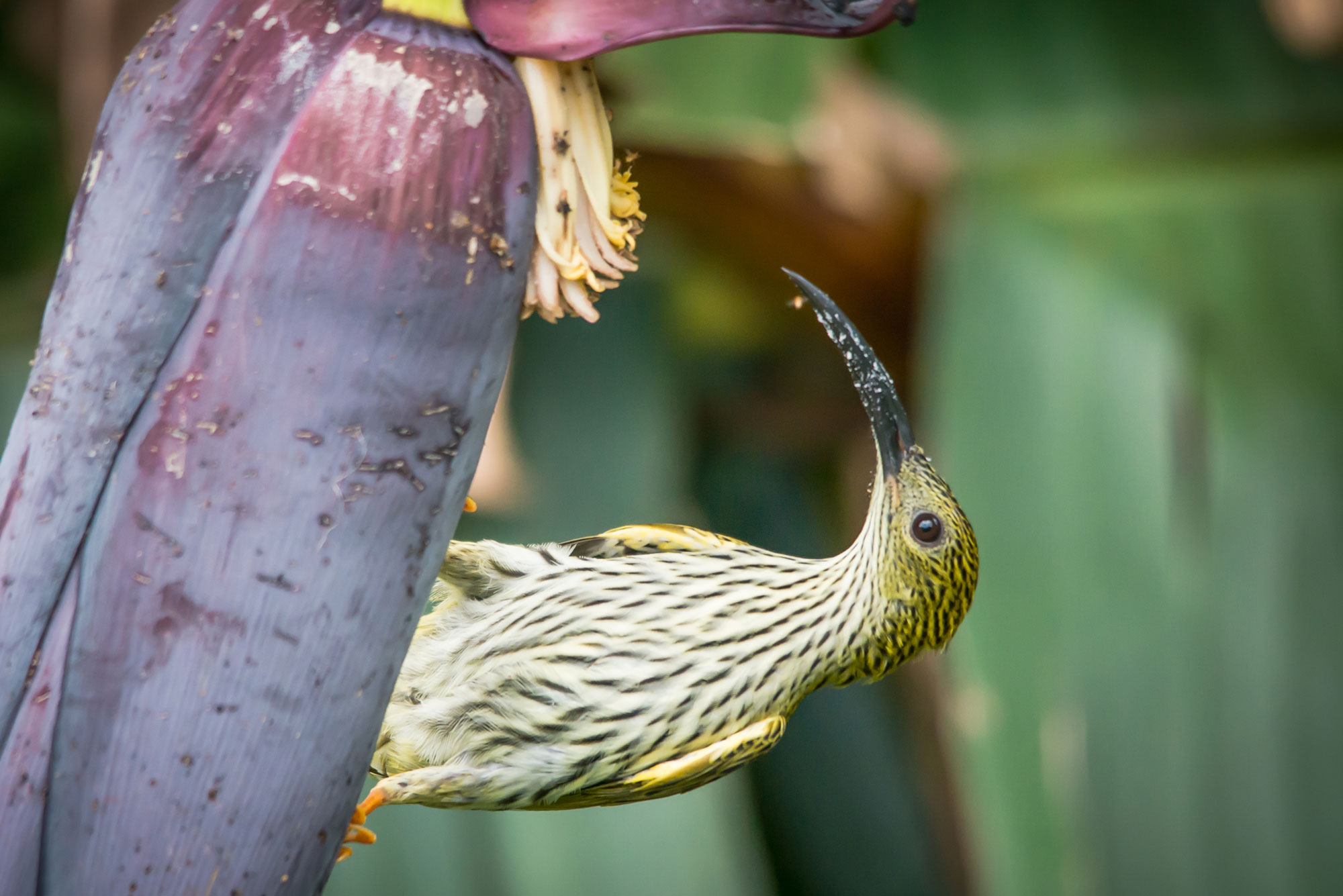 Kaeng Krachan NP is the largest national park in Thailand. Its topography is rugged mountains on the eastern slope of the Tenasserim Ranges. Sixty percent of the total area has slope greater than 30% and the highest peak is 1,513 m. above sea level. The park is an important watershed area for the Phetchaburi and Pranburi Rivers. Almost 96 percent of the total area is forested. The remainder is in agricultural use (2.24%), rehabilitation (0.67%), and water (0.98%). There are five main plant communities: mixed deciduous forest, dry dipterocarp forest, montane evergreen forest, dry evergreen forest, and moist evergreen forest. The majority of the forest area (64%) is intact dry evergreen forest. Presently, 1,199 plant species have been identified. This area is a meeting place of four plant geographical divisions: (1) Indo-Burmese or Himalayan region (Himalayan); (2) Indo- Malaysian region; (3) Annamatic; and (4) Andamanese. Magnolia mediocris and M. gustavii are two endemic plants of Thailand that can be found only in the Kaeng Krachan NP. A new global plant species, Trichosanthes phonsenae, was discovered in the area as well as other rare plants with high conservation value such as Reveesia pubescene Mast. var. siamensis Criab. and Mitrephora winitii Craib. Kaeng Krachan provides diverse habitats for many regionally important wildlife species as a result of being the meeting place of 4 zoological geographical regions. Six hundred and sixty five wildlife species are found in the area with 85 species of mammals, 456 species of birds, 67 species of reptiles, 23 species of amphibians, and 34 species of fishes. Kaeng Krachan is one of few known remaining natural habitats for the critically endangered (CRIUCN Red List) Siamese crocodile (Crocodylus siamensis). The endangered species (EN) found in the area are banteng (Bos javanicus), tiger (Panthera tigris), elephant (Elephas maximus) and asiatic wild dog (Cuon alpinus), asian giant tortoise (Manouria emys) and yellow tortoise (Indotestudo elongata). Other threatened species under the vulnerable species category (VU) are marbled cat (Pardofelis marmorata), clouded leopard (Neofelis nebulosa), fishing cat (Prionailurus viverrinus), asiatic golden cat (Catopuma temminckii), asian tapir (Tapirus indicus), asiatic black bear (Ursus thibetanus), gaur (Bos gaurus), serow (Capricornis sumatraensis), stumptailed macaque (Macaca arctoides), smooth coated otter (Lutrogale perspicillata), plain-pouched hornbill (Aceros subruficollis), blue-banded kingfisher (Alcedo euryzona), white-fronted scops-owl (Otus Sagittatus), pale-capped pigeon (Columba punicea), wood snipe (Gallinago nemoricola), silver oriole (Oriolus mellianus), and greysided thrush (Turdus feae). Kaeng Krachan is also rich in butterflies, with 292 recorded from a total of 1,300 species in Thailand. Kui Buri NP is the second largest unit in this complex and has rugged mountainous topography as a part of the Tenasserim Ranges but also rolling hills to the east.
The altitude of Kui Buri NP is between 200-985 meter above sea level and the park is a watershed area for the Pranburi and Kui Buri Rivers. Almost 97% of the national park is forested with agriculture, and water resources comprising the remainder. Three main forest types are found: dry evergreen forest (62.02%), moist evergreen forest (28.87%), mixed deciduous forest (6.19%) and secondary forest (2.92%). Kui Buri NP is a major reservoir for wildlife in the country and the region with at least 250 wildlife species (48 species of mammals, 145 species of birds, 23 species of reptiles, 15 species of amphibians, and 19 species of fish). Some endangered species (EN) are found in this national park such as elephant (Elephas maximus), banteng (Bos javanicus), tiger (Panthera tigris), leopard (Panthera pardus), and Asiatic wild dog (Cuon alpinus). Vulnerable species (VU) include clouded leopard (Pardofelis nebulosa), Asian tapir (Tapirus indicus), and southern serow (Capricornis sumatraensis). Chaloem Phrakiat Thai Prachan NP has a rugged topography and is also a part of the Tenasserim Ranges. The highest peak has an altitude of 806 meter above sea level. Thai Prachan is the head waters of the Mae Prachan River, Phachi River, Mae Klong River, and Phetchaburi River. Almost all the park (97.27%) is covered with 4 types of forest, which are mixed deciduous forest (68.94%), moist evergreen forest (14.83%), dry evergreen forest (13.77%), and dry dipterocarp forest (0.71%) with secondary forest (1.75%). Thai Prachan NP contains various types of habitat for wildlife. Since the area is adjacent to Kaeng Krachan NP wildlife can easily move between the two areas. At least 268 wildlife species have been identified with 69 species of mammals, 137 species of birds, 33 species of reptiles, 21 species of amphibians, and 8 species of fish. Some endangered species (EN) are found in this park such as banteng (Bos javanicus) and tiger (Panthera tigris). Southern serow (Capricornis sumatraensis), clouded leopard (Pardofelis nebulosa) as well as asian golden cat (Catopuma temminckii) are vulnerable species (VU) found in CPNP. Other interesting wildlife in this area are banded langur (Presbytis femoralis) and sunda pangolin (Manis javanica). A fish species, Schistura balteata, is khown as the first record for Thailand.
Kaeng Krachan NP is the largest national park in Thailand. Its topography is rugged mountains on the eastern slope of the Tenasserim Ranges. Sixty percent of the total area has slope greater than 30% and the highest peak is 1,513 m. above sea level. The park is an important watershed area for the Phetchaburi and Pranburi Rivers. Almost 96 percent of the total area is forested. The remainder is in agricultural use (2.24%), rehabilitation (0.67%), and water (0.98%). There are five main plant communities: mixed deciduous forest, dry dipterocarp forest, montane evergreen forest, dry evergreen forest, and moist evergreen forest. The majority of the forest area (64%) is intact dry evergreen forest. Presently, 1,199 plant species have been identified. This area is a meeting place of four plant geographical divisions: (1) Indo-Burmese or Himalayan region (Himalayan); (2) Indo- Malaysian region; (3) Annamatic; and (4) Andamanese. Magnolia mediocris and M. gustavii are two endemic plants of Thailand that can be found only in the Kaeng Krachan NP. A new global plant species, Trichosanthes phonsenae, was discovered in the area as well as other rare plants with high conservation value such as Reveesia pubescene Mast. var. siamensis Criab. and Mitrephora winitii Craib. Kaeng Krachan provides diverse habitats for many regionally important wildlife species as a result of being the meeting place of 4 zoological geographical regions. Six hundred and sixty five wildlife species are found in the area with 85 species of mammals, 456 species of birds, 67 species of reptiles, 23 species of amphibians, and 34 species of fishes. Kaeng Krachan is one of few known remaining natural habitats for the critically endangered (CRIUCN Red List) Siamese crocodile (Crocodylus siamensis). The endangered species (EN) found in the area are banteng (Bos javanicus), tiger (Panthera tigris), elephant (Elephas maximus) and asiatic wild dog (Cuon alpinus), asian giant tortoise (Manouria emys) and yellow tortoise (Indotestudo elongata). Other threatened species under the vulnerable species category (VU) are marbled cat (Pardofelis marmorata), clouded leopard (Neofelis nebulosa), fishing cat (Prionailurus viverrinus), asiatic golden cat (Catopuma temminckii), asian tapir (Tapirus indicus), asiatic black bear (Ursus thibetanus), gaur (Bos gaurus), serow (Capricornis sumatraensis), stumptailed macaque (Macaca arctoides), smooth coated otter (Lutrogale perspicillata), plain-pouched hornbill (Aceros subruficollis), blue-banded kingfisher (Alcedo euryzona), white-fronted scops-owl (Otus Sagittatus), pale-capped pigeon (Columba punicea), wood snipe (Gallinago nemoricola), silver oriole (Oriolus mellianus), and greysided thrush (Turdus feae). Kaeng Krachan is also rich in butterflies, with 292 recorded from a total of 1,300 species in Thailand. Kui Buri NP is the second largest unit in this complex and has rugged mountainous topography as a part of the Tenasserim Ranges but also rolling hills to the east.
The altitude of Kui Buri NP is between 200-985 meter above sea level and the park is a watershed area for the Pranburi and Kui Buri Rivers. Almost 97% of the national park is forested with agriculture, and water resources comprising the remainder. Three main forest types are found: dry evergreen forest (62.02%), moist evergreen forest (28.87%), mixed deciduous forest (6.19%) and secondary forest (2.92%). Kui Buri NP is a major reservoir for wildlife in the country and the region with at least 250 wildlife species (48 species of mammals, 145 species of birds, 23 species of reptiles, 15 species of amphibians, and 19 species of fish). Some endangered species (EN) are found in this national park such as elephant (Elephas maximus), banteng (Bos javanicus), tiger (Panthera tigris), leopard (Panthera pardus), and Asiatic wild dog (Cuon alpinus). Vulnerable species (VU) include clouded leopard (Pardofelis nebulosa), Asian tapir (Tapirus indicus), and southern serow (Capricornis sumatraensis). Chaloem Phrakiat Thai Prachan NP has a rugged topography and is also a part of the Tenasserim Ranges. The highest peak has an altitude of 806 meter above sea level. Thai Prachan is the head waters of the Mae Prachan River, Phachi River, Mae Klong River, and Phetchaburi River. Almost all the park (97.27%) is covered with 4 types of forest, which are mixed deciduous forest (68.94%), moist evergreen forest (14.83%), dry evergreen forest (13.77%), and dry dipterocarp forest (0.71%) with secondary forest (1.75%). Thai Prachan NP contains various types of habitat for wildlife. Since the area is adjacent to Kaeng Krachan NP wildlife can easily move between the two areas. At least 268 wildlife species have been identified with 69 species of mammals, 137 species of birds, 33 species of reptiles, 21 species of amphibians, and 8 species of fish. Some endangered species (EN) are found in this park such as banteng (Bos javanicus) and tiger (Panthera tigris). Southern serow (Capricornis sumatraensis), clouded leopard (Pardofelis nebulosa) as well as asian golden cat (Catopuma temminckii) are vulnerable species (VU) found in CPNP. Other interesting wildlife in this area are banded langur (Presbytis femoralis) and sunda pangolin (Manis javanica). A fish species, Schistura balteata, is khown as the first record for Thailand.
Criterion (x)
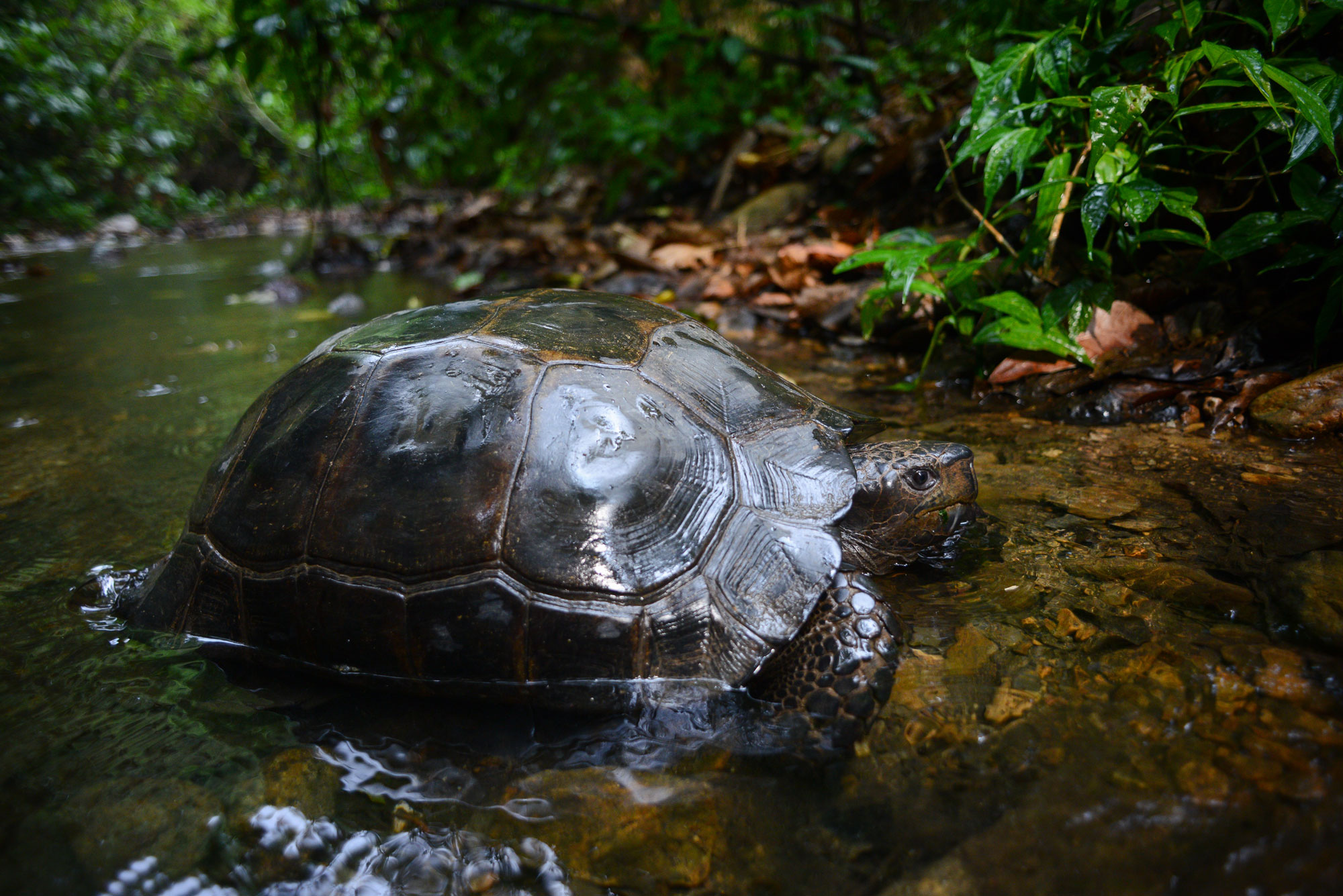 Contain the most important and significant natural habitats for in-situ conservation of biological diversity, including those containing threatened species of Outstanding Universal Value from the point of view of science or conservation. The nominated property meets this criterion due to its location as a zone of mixing between different zoogeographical realms and floristic provinces. It is the northernmost point for many species from the south and the southernmost point for species from the north. This macrodiversity is complemented by a highly variable topography that creates many different habitats per unit. Symptomatic of the high biodiversity in the area is the presence of at least 720 known wild animal species and presence of endemic plant species such as Magnolia mediocris and M. gustavii, their only location in Thailand. Trichosanthes phonsenae is another plant species and the complex represents its only known location in the world today. In addition, the complex maintains important populations of globally endangered species. Of special note is the presence of the critically endangered, Siamese crocodile (Crocodylus siamensis) in Kaeng Krachan National Park, one of few locations in only three countries worldwide where it still exists in the wild. In addition, there are also important populations of other endangered species such as banteng (Bos javanicus), Asian elephant (Elephas maximus), tiger (Panthera tigris), Asiatic wild dog (Cuon alpinus), Asian giant tortoise (Manouria emys); and vulnerable species such as Asian black bear (Ursus thibetanus), Asian tapir (Tapirus indicus), southern serow (Capricornis sumatraensis) and stump- tailed macaque (Macaca arctoides). A complete suite of top carnivores has been identified in the area including eight species of wild cats.
Contain the most important and significant natural habitats for in-situ conservation of biological diversity, including those containing threatened species of Outstanding Universal Value from the point of view of science or conservation. The nominated property meets this criterion due to its location as a zone of mixing between different zoogeographical realms and floristic provinces. It is the northernmost point for many species from the south and the southernmost point for species from the north. This macrodiversity is complemented by a highly variable topography that creates many different habitats per unit. Symptomatic of the high biodiversity in the area is the presence of at least 720 known wild animal species and presence of endemic plant species such as Magnolia mediocris and M. gustavii, their only location in Thailand. Trichosanthes phonsenae is another plant species and the complex represents its only known location in the world today. In addition, the complex maintains important populations of globally endangered species. Of special note is the presence of the critically endangered, Siamese crocodile (Crocodylus siamensis) in Kaeng Krachan National Park, one of few locations in only three countries worldwide where it still exists in the wild. In addition, there are also important populations of other endangered species such as banteng (Bos javanicus), Asian elephant (Elephas maximus), tiger (Panthera tigris), Asiatic wild dog (Cuon alpinus), Asian giant tortoise (Manouria emys); and vulnerable species such as Asian black bear (Ursus thibetanus), Asian tapir (Tapirus indicus), southern serow (Capricornis sumatraensis) and stump- tailed macaque (Macaca arctoides). A complete suite of top carnivores has been identified in the area including eight species of wild cats.
Status
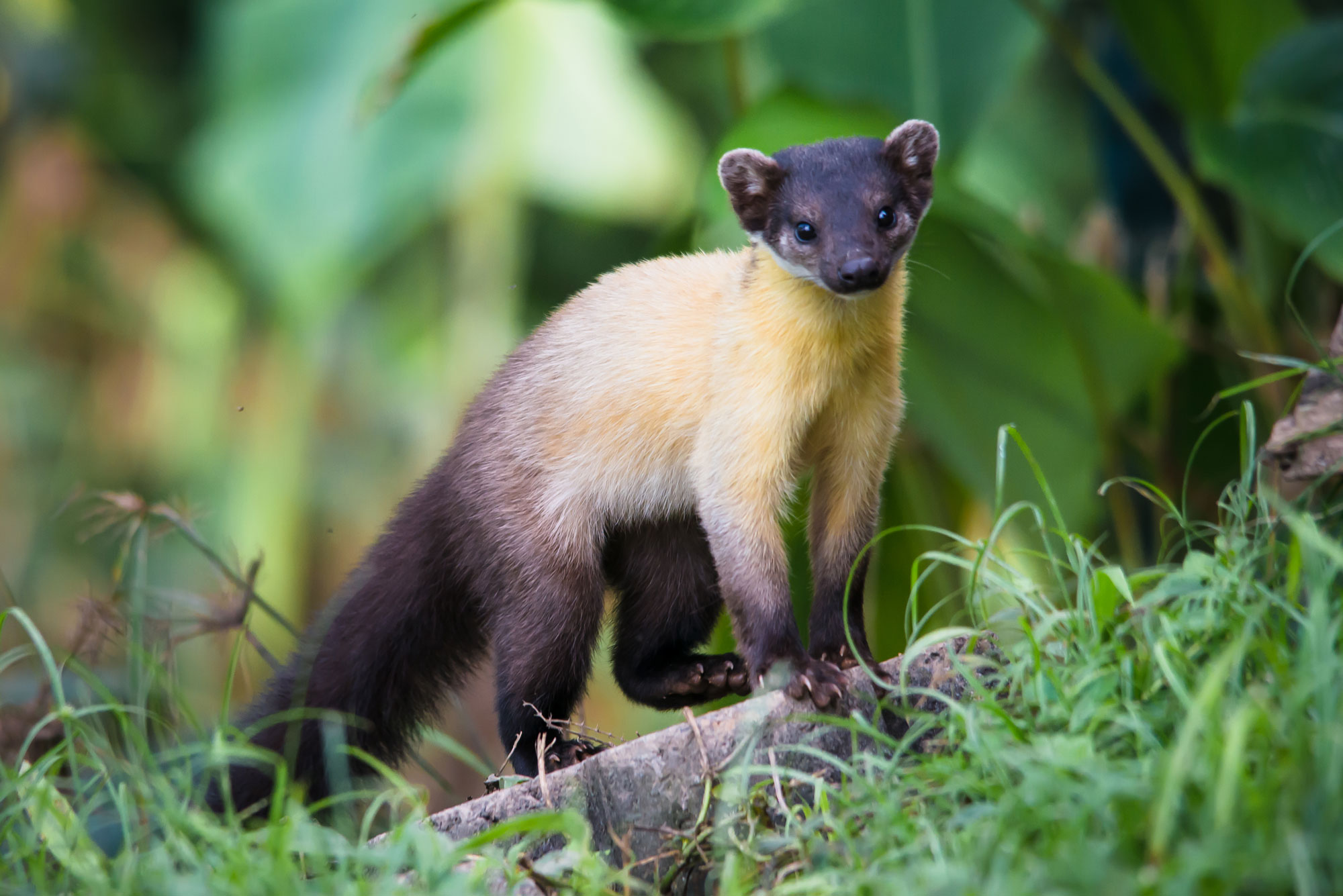 The KKFC is crucial in safeguarding the origins of numerous significant rivers, including the Phetchaburi, Kui Buri, Pranburi, Phachi, and Mae Klong Rivers. Notably, a subset of these rivers served as water sources for the Sam Roi Yod National Park, renowned as a Ramsar Site and celebrated for its abundance of water birds within Thailand. Encompassing an expansive area of 482,225 hectares, the KKFC extends across Ratchaburi, Phetchaburi, and Prachuab Kirikhan. This protected region naturally connects with a forested expanse in Myanmar, with the Tenasserim Ranges forming a natural boundary that spans approximately 292 kilometers from the property's northern edge to its southern limit. Within the KKFC, a diverse array of six distinct forest types thrives, collectively covering 96.43% of the entire landscape. Remarkably, the dry evergreen forest encompasses 59% of the territory. The remaining forest types include Mixed Deciduous forest, Montane Evergreen forest, Moist Evergreen forest, Secondary Forest, and Dry Dipterocarp forest. The area's topography is characterized by its rugged nature, featuring towering mountains in the western portion and undulating hills in the eastern parts. Elevations span from 100 to 1,500 meters above sea level. Climate patterns are influenced by both the north-eastern and south-western monsoon winds. The rainy season generally initiates in mid-May and concludes around mid-October, followed by the winter season extending from mid-October to mid-February, and finally, the dry season prevailing from mid-February to mid-May. The outstanding natural attributes and considerable ecotourism potential have propelled the KKNP into the limelight as a celebrated destination among eco-tourists. However, the region grapples with pressing issues such as land fragmentation, encroachment, illicit hunting, and unauthorized non- timber forest product (NTFP) collection. From a legal perspective, the KKFC complex comprises four officially designated protected areas: the Mae Nam Phachi Wildlife Sanctuary, established under the Wildlife Protection and Preservation Act of 1992, alongside three national parks—Chaloem Phrakiat Thai Prachan, Kaeng Krachan, and Kui Buri—recognized under the National Park Act of 1961. The connection between Kaeng Krachan and Kui Buri National Parks is facilitated by the Kui Buri Forest Reserve and the Army Reserve Zone, governed respectively by the Forest Reserve Act of 1964 and the Military Reserve Zone Act of 1935. The KKFC spans an extensive area, functioning as a guardian of the region's overall ecological equilibrium, including its exceptional wildlife values. Moreover, it safeguards the forests that play an integral role in the watershed of Petchaburi and Prajuab Kirikhan provinces. The administrative structure comprises a Unit Superintendent at the helm, supported by deputy officials assigned to each component. Additionally, a network of patrol stations strategically situated within and around the boundaries carries out consistent enforcement and outreach activities, ensuring the preservation and protection of this significant ecological enclave.
The KKFC is crucial in safeguarding the origins of numerous significant rivers, including the Phetchaburi, Kui Buri, Pranburi, Phachi, and Mae Klong Rivers. Notably, a subset of these rivers served as water sources for the Sam Roi Yod National Park, renowned as a Ramsar Site and celebrated for its abundance of water birds within Thailand. Encompassing an expansive area of 482,225 hectares, the KKFC extends across Ratchaburi, Phetchaburi, and Prachuab Kirikhan. This protected region naturally connects with a forested expanse in Myanmar, with the Tenasserim Ranges forming a natural boundary that spans approximately 292 kilometers from the property's northern edge to its southern limit. Within the KKFC, a diverse array of six distinct forest types thrives, collectively covering 96.43% of the entire landscape. Remarkably, the dry evergreen forest encompasses 59% of the territory. The remaining forest types include Mixed Deciduous forest, Montane Evergreen forest, Moist Evergreen forest, Secondary Forest, and Dry Dipterocarp forest. The area's topography is characterized by its rugged nature, featuring towering mountains in the western portion and undulating hills in the eastern parts. Elevations span from 100 to 1,500 meters above sea level. Climate patterns are influenced by both the north-eastern and south-western monsoon winds. The rainy season generally initiates in mid-May and concludes around mid-October, followed by the winter season extending from mid-October to mid-February, and finally, the dry season prevailing from mid-February to mid-May. The outstanding natural attributes and considerable ecotourism potential have propelled the KKNP into the limelight as a celebrated destination among eco-tourists. However, the region grapples with pressing issues such as land fragmentation, encroachment, illicit hunting, and unauthorized non- timber forest product (NTFP) collection. From a legal perspective, the KKFC complex comprises four officially designated protected areas: the Mae Nam Phachi Wildlife Sanctuary, established under the Wildlife Protection and Preservation Act of 1992, alongside three national parks—Chaloem Phrakiat Thai Prachan, Kaeng Krachan, and Kui Buri—recognized under the National Park Act of 1961. The connection between Kaeng Krachan and Kui Buri National Parks is facilitated by the Kui Buri Forest Reserve and the Army Reserve Zone, governed respectively by the Forest Reserve Act of 1964 and the Military Reserve Zone Act of 1935. The KKFC spans an extensive area, functioning as a guardian of the region's overall ecological equilibrium, including its exceptional wildlife values. Moreover, it safeguards the forests that play an integral role in the watershed of Petchaburi and Prajuab Kirikhan provinces. The administrative structure comprises a Unit Superintendent at the helm, supported by deputy officials assigned to each component. Additionally, a network of patrol stations strategically situated within and around the boundaries carries out consistent enforcement and outreach activities, ensuring the preservation and protection of this significant ecological enclave.
